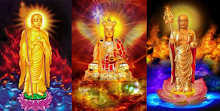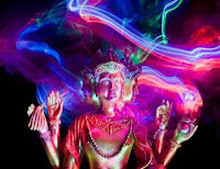
 The Buddhas of Bamiyan, Afghanistan -- which the maverick scholar and historian Ranajit Pal, Ph.D. considers to be in vicinity of the original Kapilavastu, where Siddhartha grew up -- is ancient land in Himalayan foothills.
The Buddhas of Bamiyan, Afghanistan -- which the maverick scholar and historian Ranajit Pal, Ph.D. considers to be in vicinity of the original Kapilavastu, where Siddhartha grew up -- is ancient land in Himalayan foothills.
Buddhism is steeped in the geography of ancient Greater India (Maha Bharat), which at the time of the Buddha was a collection of loosely aligned territories. There are relics and markers throughout the region (many now outside the country) including ancient northwest Gandhara, present-day Afghanistan and Pakistan.
 |
| Note people on foot. The tallest of the Buddhas of Bamiyan may not be the biggest in Asia. |
India, and its Shakyan neighbor in the northwest, was expansive and fluid. People were aligned with extended family clans, and united by commonalities in language and trade. Buddhism and its precursor "wandering ascetic" (shramana) tradition are found even in the preceding Harappan era along with much of the history the Buddha mentioned, which we can assume was from the Indus Valley Civilization and earlier.
 |
| Bamiyan valley looking north to snow capped Himalayan range of Koh-i-Baba/Hindu Kush |
 Buddhas are spoken of as having arisen in previous aeons, far earlier than modern archeology is willing to concede that modern humans existed. But another maverick historian and archeologist shows evidence of the great antiquity of humanity (and hybrids) on this planet: Michael Cremo, who is informed not only by science but the ancient Vedas as well, as humans have been devolving through the ages.
Buddhas are spoken of as having arisen in previous aeons, far earlier than modern archeology is willing to concede that modern humans existed. But another maverick historian and archeologist shows evidence of the great antiquity of humanity (and hybrids) on this planet: Michael Cremo, who is informed not only by science but the ancient Vedas as well, as humans have been devolving through the ages.
The area of Bamiyan in Central Asia was Zoroastrian, founded by the asura Zoroaster (Zarathustra), and Buddhist at one time, that is, whatever fragments or memories remained of pre-Shakyamuni buddhas. before Gotama which implies that Buddhism was as old as Zoroastrianism. Dr. Pal contends that "detailed study reveals close links of early Buddhism with Hinduism, Judaism and Zoroastrianism which rose in the Bamiyan-Baluchistan-Gandhara area."
 |
| The viewing point over Bamiyan valley from within the head of the tallest Buddha statue |
 (Holger Kersten is an excellent resource for information on ancient Jewish outposts in India). "The crucial fact that the Silk Road passed through the Buddhist heartland has escaped the notice of all," Dr. Pal explains. This is how Buddhism spread, even as the Buddha Gautama went back and forth from his native Kapilavastu to the ancient central kingdom of India, Magadha, where he otherwise spent much of his time teaching. He early on sent enlightened missionaries in all directions to spread the Dharma. They must have reached at least as far as Kalmykia, in indigenously Buddhist Europe.
(Holger Kersten is an excellent resource for information on ancient Jewish outposts in India). "The crucial fact that the Silk Road passed through the Buddhist heartland has escaped the notice of all," Dr. Pal explains. This is how Buddhism spread, even as the Buddha Gautama went back and forth from his native Kapilavastu to the ancient central kingdom of India, Magadha, where he otherwise spent much of his time teaching. He early on sent enlightened missionaries in all directions to spread the Dharma. They must have reached at least as far as Kalmykia, in indigenously Buddhist Europe. |
| Band-e Amir Bahar, west of and within two miles of the famous Buddhas of Bamiyan |
Lumbini (Siddhartha's garden birthplace) or Kapilavastu (his hometown) in Nepal is, Dr. Pal contends, an archeological and historical "fraud." Wisdom Quarterly much to the chagrin of the governments of Islamic Afghanistan and Hindu-dominated Nepal and India. (Nepal was once the only Hindu nation in the world; India never was; they both now lean secular with a great financial interest in Buddhist tourism and history). Dr. Pal points out that, "Nothing in the art, archaeology, history or literature of early Nepal has the faintest hint of Buddhism." More photos
 |
| Shakya -- Siddhartha's clan name -- means "grey earth," a strange feature of Afghanistan. |
Reassembling the Bamiyan fragments after the CIA/Taliban's destruction
- The Buddhas as Wonders of Bamiyan
- Searching for the Buddha's maternal home
- Afghanistan copper mining will crush Afghan site
- The Buddha's words can douse rancor and discord
- The REAL Invisible History of Afghanistan
- Deciding between heritage and hard cash in Afghanistan
- VIDEO: Monk from Buddhist mission to Ladakh honored
- PHOTOS: Bhutan, Buddhist Land Beyond Heaven and Earth



















































































































































































































































No comments:
Post a Comment